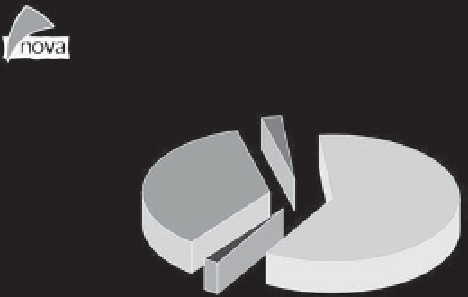Agriculture Reference
In-Depth Information
established or the hemp insulation material
market decreases.
'Exotic natural fibres' can be itemized for
2005, which previously had not been possible
due to lack of the respective data. The most
important exotic fibres are jute and kenaf with
11%, followed by sisal with 7%.
While jute is by far the fibre with the highest
turnover worldwide, thus making it the 'leading
fibre' among technical NF, insufficient data are
available for kenaf. In the trade sector, jute and
kenaf are often not differentiated from one
another properly. For this reason, these two
Asian fibres are always listed together. Sisal is the
second most important technical NF worldwide,
coming mainly from Africa and South America.
Other exotic fibres, particularly coir from
Southern Asia, are used in the first exterior
part of the framework in the press flow mould-
ing process. A couple of other natural fibres
can be used for composites.
Compression moulding, which has been used
more than 99% in recent years, has since
declined to 95%.
For the first time - in the use of natural
fibres - two new techniques can be observed:
press flow moulding and injection moulding.
For both techniques, considerable increases
are possible in the coming years, while com-
pression moulding seems to have entered a
phase of saturation. This is due partly to the
fact that its main field of application is high-
class interior parts of the medium and luxury
class, where it is hard to achieve further
growth (see also section 11.11).
Currently, it is often said that NF com-
pression moulding has passed its peak, already
being on a downward swing. Our survey
cannot confirm this, but merely detects a stag-
nation. However, a shift among suppliers is
noticeable, which could explain the impres-
sion mentioned above: while, indeed, the
production of NF compression moulding parts
is decreasing quantitatively among many
small and medium suppliers, production
accordingly is increasing among a few large
suppliers, thus compensating for the decrease
among the smaller suppliers. When asking all
suppliers, one necessarily gets the impression
that compression moulding is declining for
the most part - although it remains quali-
tatively constant.
11.5 Shares of Different
Production Techniques
Figure 11.3 shows the range of different pro-
duction techniques for NF composites. As in
recent years, compression moulding is domi-
nant, though slightly less than previously.
press flow-
moulding**
2%
thermoplast
press-moulding
61%
thermoset
press-moulding
35%
injection
moulding**
2%
* without wood and cotton
** straight thermoplast procesing
technology
Fig. 11.3.
Shares of different processing technologies of natural fibre composites (not including wood or
cotton) in the German automotive industry in 2005 (nova-Institut, November 2006).

